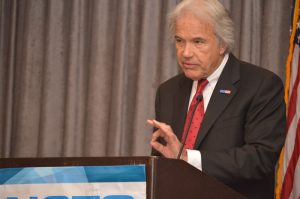
At the 15th annual NCTO meeting, outgoing Chairman William V. McCrary Jr. painted a picture of the U.S. textile industry and the association’s achievements and upcoming goals.
By William V. McCrary Jr.
It has been an amazing year for the U.S. textile industry and the National Council of Textile Organizations (NCTO). President Trump’s pro-manufacturing agenda is forcing Washington to do what NCTO has long sought — rethink policies on trade, taxation, regulatory reform and a host of other issues.
Let there be no doubt. The time for change is now and NCTO is committed to working with the Trump administration to achieve the best policy outcomes on these and other issues. But before laying out NCTO’s policy agenda, I want to recap how the industry fared in 2017.
Editor’s Note: The North American Industry Classification System (NAICS) is the standard used by Federal statistical agencies in classifying business establishments for the purpose of collecting, analyzing, and publishing statistical data related to the U.S. business economy. NAICS Subsector 313 covers Textile Mills, subsector 314 covers Textile Product Mills and subsector 315 covers Apparel.
The Numbers
Thanks to its productivity, flexibility and innovation, the U.S. textile industry has cemented its position in the global market.
In 2017, the value of U.S. man-made fiber and filament, textile, and apparel shipments totaled an estimated $77.9 billion. this is an uptick from the $74.4 billion in output in 2016 and an increase of 16 percent since 2009.1
The breakdown of 2017 shipments by industry sector is:2
- $31.5 billion for yarns and fabrics;
- $26.6 billion for home furnishings, carpet & other non-apparel sewn products;
- $12.5 billion for apparel; and
- an estimated $7.3 billion for man-made fibers.
Capital expenditures also are healthy. Investment in fiber, yarn, fabric, and other non-apparel textile product manufacturing has more than doubled from $960 million in 2009 to $2.1 billion in 2016.3
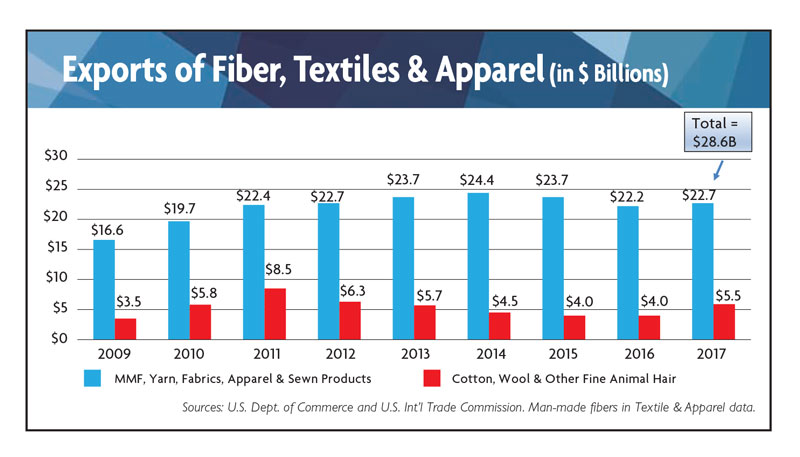 The sector’s supply chain employs 550,500 workers.4 The 2017 figures include:
The sector’s supply chain employs 550,500 workers.4 The 2017 figures include:
- 112,300 jobs in yarns and fabrics;
- 114,700 jobs in home furnishings, carpet, and other non-apparel sewn products;
- 119,300 jobs in apparel manufacturing;
- 25,100 jobs in man-made fibers;
- 126,600 jobs in cotton farming and related industry; and
- 52,500 jobs in wool growing and related industry.
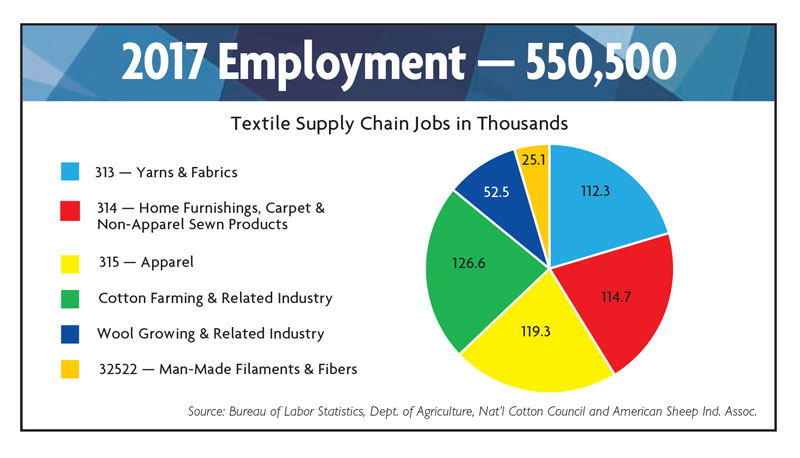 As we examine these numbers, it is important to note that the heavy job losses incurred because of massive import surges in the 1995-2008 time frame, virtually have stopped.5 Today, like most other U.S. manufacturing sectors, fluctuations in employment figures are generally due to normal business cycles, new investment, or productivity increases.
As we examine these numbers, it is important to note that the heavy job losses incurred because of massive import surges in the 1995-2008 time frame, virtually have stopped.5 Today, like most other U.S. manufacturing sectors, fluctuations in employment figures are generally due to normal business cycles, new investment, or productivity increases.
U.S. exports of fiber, yarns, fabrics, made-ups, and apparel were $28.6 billion in 2017.6 This is nearly a nine percent increase in export performance over 2016. Shipments to NAFTA and CAFTA-DR countries accounted for 54 percent of all U.S. textile supply chain exports.
The breakdown of exports by sector is as follows:
- $5.9 billion – cotton and wool;
- $4.4 billion – yarns;
- $8.9 billion – fabrics;
- $3.7 billion – home furnishings, carpet & other non-apparel sewn products; and
- $5.7 billion – apparel.
 The United States is especially well-positioned globally in fiber, yarn, fabric, and non-apparel sewn products markets; it was the world’s 4th largest individual country exporter of those products in 2016.7
The United States is especially well-positioned globally in fiber, yarn, fabric, and non-apparel sewn products markets; it was the world’s 4th largest individual country exporter of those products in 2016.7
The most important U.S. export markets by region are:8
- $11.85 billion – NAFTA;
- $3.4 billion – CAFTA-DR;
- $8.7 billion – Asia;
- $2.8 billion – Europe; and
- $2.0 billion – Rest of World.
Focusing solely on America’s $13 billion in man-made fiber, yarn and fabric exports, the countries buying the most product are9:
- $4.4 billion – Mexico;
- $1.7 billion – Canada;
- $1.3 billion – Honduras;
- $987 million – China; and
- $473 million – Dominican Republic.
The numbers show the fundamentals for the U.S. textile industry are sound. This is true even though some markets for U.S. textiles and apparel were soft last year. For the most part, any sluggishness was due to factors beyond control, such as disruption in the retail sector caused by the shifting of sales from brick and mortar outlets to the internet. With that said, the U.S. textile industry’s commitment to capital reinvestment and a continued emphasis on quality and innovation make it well-positioned to adapt to market changes and take advantage of opportunities as 2018 moves along.
Policy Issues
For decades, U.S. policy systematically undervalued the importance of domestic manufacturing, and President Trump is right that this has hurt America.
As evidenced by the work done by NCTO’s government relations team, NCTO endorses President Trump’s macro policy objectives of reshoring industry, fighting for free, but fair trade, enforcing U.S. trade laws, making the U.S. tax code more competitive, buying American, cutting unnecessary regulation, revitalizing infrastructure, ensuring cheap energy, and fixing health care.
On trade, NCTO agrees with President Trump that U.S. trading relationships must be rooted in fairness and reciprocity to benefit a broad swath of American society.
America’s most important trading relationship is NAFTA, a pillar upon which the U.S.-Western Hemisphere textile supply chain is built. At almost $12 billion combined, Mexico and Canada are the U.S. textile industry’s largest export markets. Moreover, Mexico provides vital garment assembly capacity the United States lacks at this time.
Let me be clear, NCTO strongly supports NAFTA. That said, NCTO agrees with President Trump that NAFTA can and must be improved.
NAFTA’s yarn-forward rule of origin contains loopholes that benefit third-party countries, such as China. Closing them would boost U.S. and NAFTA partner textile and apparel production and jobs.
NCTO’s NAFTA objectives include:
- Eliminating tariff preference levels (TPLs) on apparel, non-apparel sewn products, fabrics and yarn;
- Requiring use of NAFTA-origin components beyond the “essential character” of the fabric – sewing thread, pocketing and narrow elastics, for example;
- Strengthening buy American laws for Dept. of Homeland Security textiles and clothing by closing the Kissell Amendment loophole for Canada and Mexico; and
- Strengthening customs enforcement.
NCTO further agrees with President Trump that all U.S. free trade agreements should be periodically reviewed on a performance basis.
As for any new trade deals, NCTO supports President Trump’s preference for individual bilateral free trade agreements (FTAs) over multilaterals. Moreover, any new FTA targets should be limited to countries that trade in a fair, reciprocal manner. NCTO would oppose any FTAs with non-market economy countries like China and Vietnam because of their demonstrated ability to disrupt the U.S. textile market.
NCTO welcomes President Trump’s view that U.S. has made a mistake by not prioritizing trade enforcement in recent years. NCTO intends to make this issue a point of emphasis in the coming months because curtailing customs fraud and enforcing trade laws incentivizes reshoring. Moreover, due to the extremely high volume of trade in our sector, the textile industry is especially susceptible to customs fraud.
For FY 2017, the U.S. International Trade Commission reports calculated duties for all imports for domestic consumption was $34.8 billion, including $13.5 billion in textile and apparel-related goods. With billions at stake, lax U.S. customs enforcement entices unscrupulous importers to avoid duty payments.
To reduce customs fraud, the United States must put a higher priority on enforcement. This means devoting more resources to investigate those who are avoiding duties by purposely undervaluing U.S. imports, illegally circumventing U.S. free trade agreement rules of origin via third-country transshipment, or other fraudulent means. In addition, penalties for customs fraud must be certain, swift, and sufficient to deter this harmful, illegal activity.
Stopping customs fraud has the added benefit of more than paying for itself. The U.S. Treasury will collect more duty revenue and more textile supply chain production and jobs will shift to the United States and the broader NAFTA and DR-CAFTA regions.
NCTO also supports tough U.S. action against countries that engage in predatory trade practices. Noting that this problem is pervasive among non-market economies, NCTO welcomes the Trump administration’s rejection of China’s demand to be recognized as a market economy under the World Trade Organization. This decision prevents China from arguing that their manufacturing cost structures are fair and transparent with respect to trade enforcement actions.
One final trade priority is the Miscellaneous Tariff Bill, a pro-jobs measure vital to U.S. competitiveness. NCTO urges swift enactment of the Miscellaneous Tariff Act, legislation providing duty relief on manufacturing inputs that are unavailable domestically and do not compete with other U.S.-made products.
Moving on to tax policy, NCTO welcomes the tax reforms enacted by President Trump and Congress. Lowering the corporate rate and providing for more favorable capital expensing will encourage more manufacturing investment in the United States.
President Trump’s initiatives to cut unnecessary regulation are pro-jobs too.
With respect to government procurement policy, NCTO steadfastly supports the Berry Amendment. This “buy American” provision for the military is an example of how the government and private sector can work together for mutual benefit. The U.S. military gets a secure U.S. supply line for thousands of superior, highly-advanced products. In return, the domestic textile sector receives $1.5 billion to $2 billion in annual Defense Department sales that boost U.S. investment and employment.
NCTO is deeply concerned by congressional attacks on the Berry Amendment in recent annual defense bills, including the 2017 National Defense Authorization Act. NCTO urges Congress to reject any proposals to weaken the Berry Amendment, and instead work to strengthen the law.
NCTO also encourages Congress to include textiles in any efforts to enact commonsense laws or regulations that would strengthen “buy American” requirements applying to infrastructure or other federal spending. As demonstrated by Berry, when the federal government buys “American,” it is good for the U.S. textile industry and even better for America.
NCTO urges Congress to follow President Trump’s lead by drafting and passing a comprehensive plan to rebuild America’s infrastructure. Besides boosting U.S. productivity and facilitating commerce, infrastructure is a key market for textile products such as workwear, geosynthetics and filtration systems. Infrastructure is a growing market for textile composites too.
Fostering a national culture of innovation is also important. NCTO urges continued support for the Advanced Functional Fabrics of America (AFFOA). This Defense Department-funded program is matched three-to-one with private dollars and tasked with making it easier to develop and commercialize the next generation of high-performance textiles.
NCTO also calls for the U.S. government to invest in improving automation for garment assembly because this technology shows promising potential to reshore U.S. textile and apparel production and jobs.
Another NCTO priority is ensuring that the U.S. textile industry has uninterrupted access to reasonably priced energy. Most man-made fibers are derivatives of petroleum products and many textile producers are reliant on natural gas to power manufacturing operations. Noting this, NCTO supports construction of expanded oil and gas pipeline capacity to keep energy prices low.
Finally, the U.S. textile industry must acknowledge its workforce is aging, making the recruitment of new talent a priority. U.S. companies must continue to forge links with local and state leaders, and educators to make sure government policy nurtures a labor pool both adequate in size and well prepared to succeed in a competitive global economy.
Other NCTO Activities
Effective April 1, NCTO merged with the American Fiber Manufacturers Association (AFMA), a fellow trade group representing domestic manufacturers of man-made fiber.
From NCTO’s perspective, the merger with AFMA adds new members, financial resources and extends NCTO’s political reach. It also enhances NCTO’s status as the voice of every facet of the U.S. textile production chain, a fact that will help NCTO more effectively influence policies made in Washington that impact U.S. textile investment, production and workers.
From AFMA’s perspective, as a multi-billion industry, it is critical that the U.S. man-made fiber sector remain engaged in Washington. Merging with NCTO allows U.S. fiber producers to keep its seat at the federal policy table.
As outlined, NCTO is involved in the policymaking process on all major matters affecting the textile production chain. This includes key international trade negotiations, congressional initiatives, federal procurement, and regulatory activity. This merger, will allow the domestic fiber sector to be fully aware of what is transpiring in these areas and to have an effective voice in influencing policy outcomes.
In other activities, NCTO’s American Textiles: We Make Amazing™ campaign is helping to rebrand the U.S. textile sector’s image because its manufacturers have a great story to tell. America’s textile industry is world-class thanks to leveraging the most cutting-edge production processes, investing in the best machinery, and leading in sustainability and innovation.
Campaign highlights include:
- Launching a new website to promote the U.S. textile industry;
- Textiles in the News (TIN), textilesinthenews.org, which debuted March 15. TIN is a sister website to NCTO’s trade association website, ncto.org. It is a platform to drive policymakers and opinion leaders to content that rebrands the U.S. textile industry along the American Textiles: We Make Amazing message;
- Publishing a third edition of Textures, NCTO’s member magazine;
- Emailing a weekly news blog, also called Textiles in the News;
- Publishing the quarterly NCTO Newsletter;
- Posting planned social media on Twitter, Facebook, and LinkedIn;
- Regular public relations outreach to selected media; and
- Generating more than $3 million in earned media coverage.
Judging by the engagement generated by American Textiles: We Make Amazing marketing efforts, more and more people are getting an accurate, positive description of our sector, and as a result, are viewing the U.S. textile industry in a new light.
Conclusion
Although the U.S. textile industry is world-class, it cannot afford to rest on its laurels. There always will be intense and sometimes unfair competition from abroad, changing consumer demands and inevitable economic downturns.
Fortunately, the Trump administration wants to spur manufacturing output and jobs, and it is incumbent upon the U.S. textile industry to seize this generational opportunity to usher in a new era of growth. With so much at stake, I implore all members of NCTO to stay active in this indispensable association that is fighting to promote the interest of our industry here in Washington.
I also invite domestic textile manufacturers who have not been active in Washington but want to change textile policy for the better, to join NCTO. Good policy does not materialize from thin air, and NCTO must have the financial and political resources necessary to help build a stable and prosperous future for U.S. textile companies. In short, our workers and their families and communities are depending on your involvement and leadership.
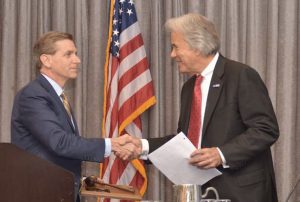
NCTO’s 15th Annual Meeting
The 2018 NCTO Annual Meeting recently wrapped at the Capital Hilton in Washington. A snowstorm cancelled many flights in and out of the regions’ airports, which left some NCTO members forced to cancel their travel, while others were delayed in their Washington arrival. The association noted meeting registrations have been on the rise over the past few years, and NCTO was looking forward to a record attendance in 2018 based on registrations until the weather intervened. However, participation was still solid and the final headcount of 140 was just under last year’s number. Attendees at the meeting represented more than 70 textile companies in addition to invited government and industry guests.
Day one of the event kicked off with meetings focused on the Berry Amendment and government contracting policies, as well as individual council meetings to organize policy for the year ahead. Day two featured speakers from AFFOA, a briefing on The United States’ budgetary outlook and a TextilePAC update. NCTO members then headed to Capitol Hill to discuss industry objectives with key members of congress. According to Lloyd Wood, NCTO’s director of public affairs, despite the snow-imposed government shut down, most of the congressional meetings lined up by NCTO took place as scheduled. Only a handful were cancelled.
During the open portion of the meeting held on the final day, outgoing NCTO Chairman William V. McCrary, president and CEO, William Barnet & Son, gave the annual State of the Textile Industry update. Following was a Cyber Security Panel comprised of Justin Zeefe, executive director and cofounder, NISOS Group; Ellen O’Day Sundra, regional vice president of System Engineering, Public Sector/Global Government, Forescout Technologies; and Jim Hemsley, IT manager, Techmer PM LLC.
The final presentations of the morning came from Robyn Boerstling, vice president of Infrastructure, Innovation and Human Resourcese Policy, National Association of Manufacturers; and Norm Orenstein, political scientist/resident scholar, American Enterprise Institute.
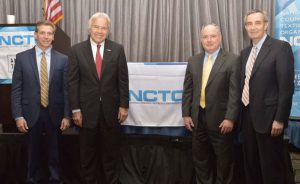
Before the meeting ended, McCrary passed the gavel to Marty Moran, CEO, Jefferson, Ga.-based Buhler Quality Yarns Corp., who was sworn in as the 2018-19 NCTO chairman. Don Bockoven, president, Leigh Fibers Inc., Wellford, S.C., will serve as the association’s 2018-19 vice chairman.
“NCTO’s 2018 annual meeting was very productive,” Moran said.“ The event covered a lot of ground on policy issues, including trade, farm bill and government procurement matters. We also visited dozens of congressional offices to drive home NCTO’s pro-jobs message on NAFTA, the Berry Amendment and other important issues.”
“My goals as 2018-19 NCTO chairman are simple,” Moran continued. “I want make sure NCTO members are kept fully informed on key issues, something especially important as NCTO welcomes new members from its recent merger with the American Fiber Manufacturers Association. Expanding NCTO’s footprint and recruiting new members is also a priority because membership is the lifeblood of any organization.”
“From a policy standpoint, NCTO must stay well positioned to shape business-friendly policies under the Trump administration. NCTO strongly supports NAFTA, but we also agree with President Trump that the agreement can and must be improved. Eliminating third-country loopholes, covering pocketing, lining, and narrow elastics, fixing the Kissell Amendment, and strengthening customs enforcement will help reshore jobs and production both domestically and regionally.”
“Finally, NCTO must keeping pressing its ‘We Make Amazing’ public relations campaign. It is essential that policy makers and the media see accurate picture of the modern U.S. textile industry and the enormous contribution we make to the national economy.”
— By Rachael S. Davis, Executive Editor
Sources:
1 Source: U.S. Census Bureau Annual Survey of Manufactures (ASM). Data covers NAICS categories 313 (Textile Mills), 314 (Textile Product Mills), 315 (Apparel), and 32522 (Artificial and Synthetic Fibers and Filaments). 2017 Data for NAICS 32522 is not yet available. Our 2017 estimate for the value of shipments in that category is $7.3 billion.
2 U.S. Census Bureau Annual Survey of Manufactures (ASM). Data covers NAICS categories 313 (Textile Mills), 314 (Textile Product Mills), 315 (Apparel), and 32522 (Artificial and Synthetic Fibers and Filaments). 2017 Data for NAICS 32522 is not yet available. Our estimate for the value of shipments in that category is based on data from 2016.
3 U.S. Census Bureau, Annual Capital Expenses Survey (ACES). Data covers NAICS categories 313 (Textile Mills), 314 (Textile Product Mills), and 315 (Apparel).
4 U.S. Bureau of Labor Statistics, U.S. Department of Agriculture, National Cotton Council, and the American Sheep Industry Association.
5 U.S. Bureau of Labor Statistics
6 Data for textiles and apparel is from The Export Market Report produced by the U.S. Department of Commerce, Office of Textiles and Apparel (OTEXA). U.S. export data for cotton, wool, and fine animal hair is calculated from the U.S. International Trade Commission Interactive Tariff and Trade DataWeb using HTS Codes 5101, 5102, 5103 (wool), 5201, 5202, and 5203 (cotton).
7 Source: U.N. COMTRADE Database, HTS Chapters 50-60
8 Source: U.S. Commerce Department and U.S. International Trade Commission
9 Id.
Editor’s Note: William “Bill” V. McCrary Jr. is chairman and CEO of Spartanburg- based William Barnet & Son LLC. He served as the 2017-2018 NCTO chairman. At the recent annual meeting in Washington, Marty Moran, CEO of Jefferson, Ga.-based Buhler Quality Yarns Corp. succeeded McCrary as NCTO chairman for 2018-19.
May/June 2018




